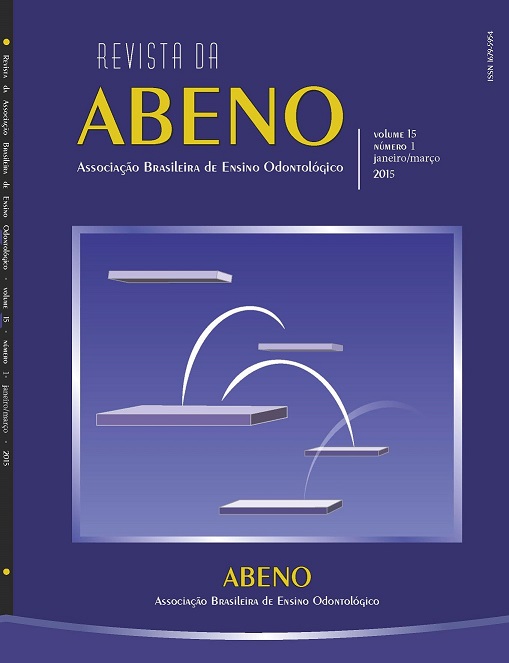Child abuse: curriculum evaluation of den-tal courses in Brazil
DOI:
https://doi.org/10.30979/rev.abeno.v15i1.155Keywords:
Violence. Child. Education. Dental.Abstract
The aim of this study was to evaluate whether the theme child abuse is addressed in the undergraduate dentistry in Brazil. This is a cross-sectional exploratory study, in which all universities in the country with the course of dentistry were questioned. Questionnaires were forwarded to all 201 coordinators of education of dentistry in Brazil, which consist in all existing courses at the time of the research. 174 questionnaires were received by the coordinators; however, only 28 were answered (response rate of 16.09%). Of these, 19 (67.8%) were private institutions, 06 (21.4%) public and 03 (10.7%) were joint management. The theme is approached by 21 institutions (75%), mainly in the disciplines of Dentistry, Forensic Dentistry and Public Health. Regarding the amount of hours designated for this theme, 16 institutions (21.19%) mentioned to reserve 08 hours or less during the course, on the other hand, 14 institutions (66.66%) stated that they were required to approach this issue within the course. Due to the importance of the theme child abuse and compared to the results of this study, it seems reasonable to conclude that this matter has been worked very incipient in Dental Courses in Brazil.
Downloads
References
Musse JO, Boing AF, Martino FS, Silva RHA, Vaccarezza GF, Ramos DLP. O Ensino da bioética nos cursos de graduação em odontologia do estado de São Paulo. Arq Ciênc Saúde 2007 jan-mar;14(1):13-6
Brasil. Ministério da Saúde. Secretaria de Assistência à Saúde.Notificação de maus-tratos contra crianças e adolescentes pelos profissionais de saúde.Um passo a mais na cidadania em saúde / Ministério da Saúde, Secretaria de Assistência à Saúde. – Brasília: Ministério da Saúde, 2002.
WHO. Preventing child maltreatment: a guide to taking action and generating evidence /World Health Organization and International Society for Prevention of Child Abuse and Neglect. 2006.p89
American Academy of Pediatrics Committee on Child Abuse and Neglect and the American Academy of Pediatric Dentistry. Guide Orient Dent Aspects Child Abuse Neglect 2010; 33(6):11-2.
Valente LA, Dalledone M, Pizzatto E, Zaiter W, de Souza JF, Losso EM Domestic violence against children and adolescents: prevalence of physical injuries in a southern Brazilian metropolis Braz Dent J. 2015 Jan-Feb; 26(1):55-60.
Cavalcanti AL. Prevalence and characteristics of injuries to the head and orofacial region in physically abused children and adolescents – a retrospective study in a city of the Northeast of Brazil. Dental Traum. 2010 Apr; 26: 149-53.
Brasil. Estatuto da criança e adolescente. Lei nº. 8.069 de 13 de julho de 1990.
El Sarraf MC, Marengo G, Correr GM, Pizzatto E, Losso EM. Physical child abuse: perception, diagnosis, and management by southern Brazilian pediatric dentists. Pediatr Dent. 2012 Jul-Aug; 34(4): 72-6.
Paola, APB. Maus-tratos na infância e adolescência: percepção e conduta dos cirurgiões dentistas da Rede Pública Municipal de Curitiba. 2012. Dissertação (Mestrado Profissional em Clínicas Odontológicas) - Universidade Positivo. p.55.
Cairns AM, Mok JYQ, Welbury RR. The dental practitioner and child protection in Scotland. Brit Dent. J 2005 Oct;199(8):517-20.
Thomas JE, Straffon L, Inglehart MR. Knowledge and professional experiences concerning child abuse: an analysis of provider and student responses. Pediatr Dent. 2006 Sep-Oct; 28(5):438-44.
Manea S, Favero GA, Stellini E, Romoli L, Mazzucato M, Facchin P. Dentists` perceptions, attitudes, knowledge, and experience about child abuse and neglect in Northeast Italy. J Clin Pediatr Dent 2007 Fall;32(1):19-25
Granville-Gracia AF, Silva MJF, Menezes VA. Maus-tratos a criança e adolescentes: Um estudo em São Bento do Uma, PE, Brasil. Pesq Bras Odontoped Clin Integr 2008 8(3);301-7.
Uldum B, Christensen HN, Welbury R, Poulsen S. Danish dentistsand dental hygienists knowledge of and experience with suspicion of child abuse or neglect. Int J Paediatr Dent 2010 Sep: 20:361-5.
Azevedo MS, Goettems ML, Brito A, Possebon AP, Domingues J, Demarco FF, Torriani DD. Child maltreatment: a survey of dentists in southern Brazil. Braz Oral Res 2012 Jan-Feb; 26(1):5-11.
Ivanoff CS, Hottel TL. Comprehensive training in suspected child abuse and neglect for dental students: a hybrid curriculum. J Dent Educ. 2013 Jun;77(6):695-705.
Losso EM, Marengo G, El Sarraf MCF, Baratto-Filho F. Child abuse: perception and management of brazilian endodontists.. RSBO. Revista Sul-Brasileira de Odontologia, 2012 jan-mar: 9 (1): 62-6.
Martins CBG, Jorge MHPM. Maus-tratos infantis: um resgate da história e das políticas de proteção. Acta Paul Enferm. 2010 23(3): 423-8.
Brasil. Conselho Nacional de Educação. 2002. Disponível em http://portal.mec.gov.br/cne/arquivos/pdf/CES032002.pdf. Acesso em 06 de agosto de 2014.
Downloads
Published
How to Cite
Issue
Section
License
Autores que publicam nesta revista concordam com os seguintes termos:
a) Autores mantém os direitos autorais e concedem à revista o direito de primeira publicação, com o trabalho simultaneamente licenciado sob a Licença Creative Commons Attribution que permite o compartilhamento do trabalho com reconhecimento da autoria e publicação inicial nesta revista.
b) Autores têm autorização para assumir contratos adicionais separadamente, para distribuição não-exclusiva da versão do trabalho publicada nesta revista (ex.: publicar em repositório institucional ou como capítulo de livro), com reconhecimento de autoria e publicação inicial nesta revista.
c) Autores têm permissão e são estimulados a publicar e distribuir seu trabalho online (ex.: em repositórios institucionais ou na sua página pessoal) a qualquer ponto antes ou durante o processo editorial, já que isso pode gerar alterações produtivas, bem como aumentar o impacto e a citação do trabalho publicado (Veja O Efeito do Acesso Livre).






